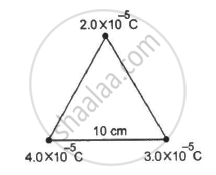Advertisements
Advertisements
प्रश्न
Two particles of masses 5.0 g each and opposite charges of +4.0 × 10−5 C and −4.0 × 10−5 C are released from rest with a separation of 1.0 m between them. Find the speeds of the particles when the separation is reduced to 50 cm.
उत्तर
Given:
Magnitude of charges, q = 4.0 × 10−5 C
Initial separation between charges, r = 1 m
Initial speed = 0; so, initial K.E. = 0
Mass of the particles, m = 5.0 g =0.005 kg
Let the required velocity of each particle be v.
By the law of conservation of energy,
Initial P.E. + Initial K.E. = Final P.E. + Final K.E.
\[\frac{1}{4\pi \epsilon_0}\frac{q_1 q_2}{r} = 2 \times \frac{1}{2}m v^2 + \frac{1}{4\pi \epsilon_0}\frac{q_1 q_2}{r/2}\]
\[ \Rightarrow \frac{- 1}{4\pi \epsilon_0}\frac{q^2}{r} = m v^2 - \frac{2}{4\pi \epsilon_0}\frac{q^2}{r}\]
\[ \Rightarrow m v^2 = \frac{1}{4\pi \epsilon_0}\frac{q^2}{r}\]
\[ \Rightarrow v = \sqrt{\frac{1}{4\pi \epsilon_0 m}\frac{q^2}{r}}\]
\[ \Rightarrow v = \sqrt{\frac{9 \times {10}^{- 9} \times \left( 4 \times {10}^{- 5} \right)^2}{0 . 005 \times 1}}\]
\[ \Rightarrow v = 53 . 66\] m/s
APPEARS IN
संबंधित प्रश्न
- Two insulated charged copper spheres A and B have their centers separated by a distance of 50 cm. What is the mutual force of electrostatic repulsion if the charge on each is 6.5 × 10−7 C? The radii of A and B are negligible compared to the distance of separation.
- What is the force of repulsion if each sphere is charged double the above amount, and the distance between them is halved?
Find the electric force between two protons separated by a distance of 1 fermi (1 fermi = 10−15 m). The protons in a nucleus remain at a separation of this order.
Estimate the number of electrons in 100 g of water. How much is the total negative charge on these electrons?
Consider a gold nucleus to be a sphere of radius 6.9 fermi in which protons and neutrons are distributed. Find the force of repulsion between two protons situated at largest separation. Why do these protons not fly apart under this repulsion?
Three equal charges, 2.0 × 10−6 C each, are held at the three corners of an equilateral triangle of side 5 cm. Find the Coulomb force experienced by one of the charges due to the other two.
Ten positively-charged particles are kept fixed on the x-axis at points x = 10 cm, 20 cm, 30 cm, ...., 100 cm. the first particle has a charge 1.0 × 10−8 C, the second 8 × 10−8 C, the third 27 × 10−8 C and so on. The tenth particle has a charge 1000 × 10−8 C. Find the magnitude of the electric force acting on a 1 C charge placed at the origin.
Repeat the previous problem if the particle C is displaced through a distance x along the line AB.
A water particle of mass 10.0 mg and with a charge of 1.50 × 10−6 C stays suspended in a room. What is the magnitude of electric field in the room? What is its direction ?
How much work has to be done in assembling three charged particles at the vertices of an equilateral triangle, as shown in the figure?
Answer the following question.
What is relative permittivity?
Write down Coulomb’s law in vector form and mention what each term represents.
SI unit of permittivity of free space is ______.
The capacity of an isolate conducting sphere of radius R is proportional to
The S.I unit of electric permittivity is
Two charges q and – 3q are placed fixed on x-axis separated by distance ‘d’. Where should a third charge 2q be placed such that it will not experience any force?
There is another useful system of units, besides the SI/mks A system, called the cgs (centimeter-gram-second) system. In this system Coloumb’s law is given by
F = `(Qq)/r^2 hatr`
where the distance r is measured in cm (= 10–2 m), F in dynes (= 10–5 N) and the charges in electrostatic units (es units), where 1 es unit of charge = `1/([3]) xx 10^-9 C`
The number [3] actually arises from the speed of light in vaccum which is now taken to be exactly given by c = 2.99792458 × 108 m/s. An approximate value of c then is c = [3] × 108 m/s.
(i) Show that the coloumb law in cgs units yields
1 esu of charge = 1 (dyne)1/2 cm.
Obtain the dimensions of units of charge in terms of mass M, length L and time T. Show that it is given in terms of fractional powers of M and L.
(ii) Write 1 esu of charge = x C, where x is a dimensionless number. Show that this gives
`1/(4pi ∈_0) = 10^-9/x^2 (N*m^2)/C^2`
With `x = 1/([3]) xx 10^-9`, we have `1/(4pi ∈_0) = [3]^2 xx 10^9 (Nm^2)/C^2`
or, `1/(4pi ∈_0) = (2.99792458)^2 xx 10^9 (Nm^2)/C^2` (exactly).
According to Coulomb's law, which is the correct relation for the following figure?

Four charges equal to −Q are placed at the four a corners of a square and charge q is at its centre. If the system is in equilibrium, the value of q is ______.
